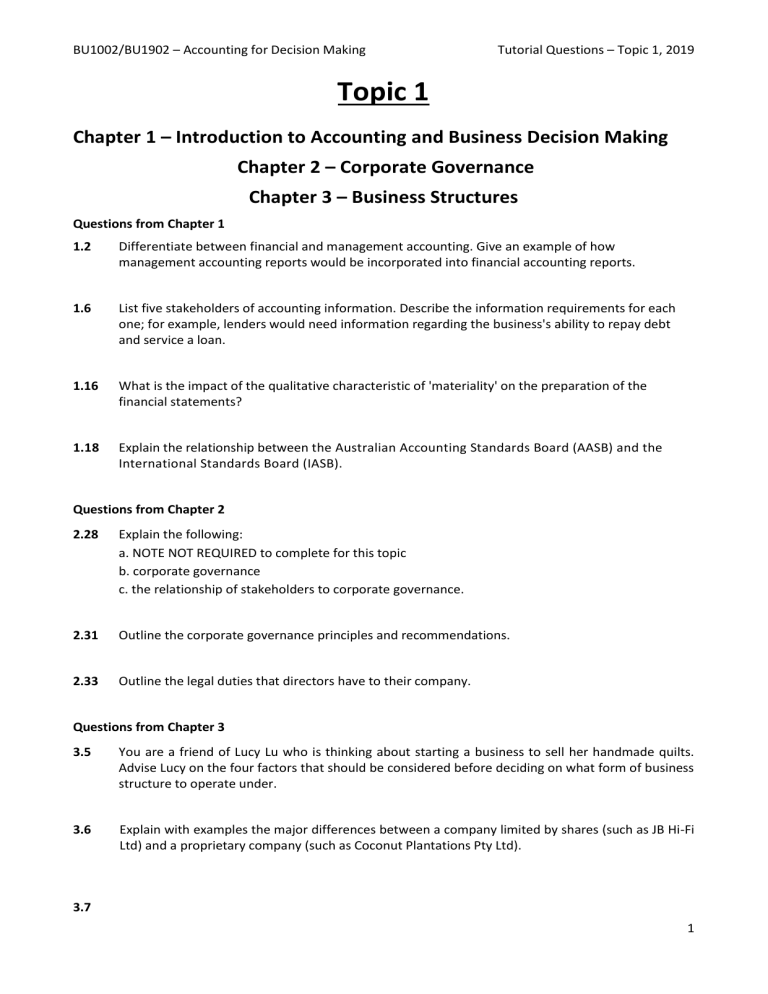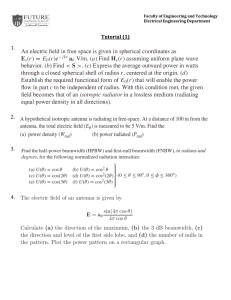
BU1002/BU1902 – Accounting for Decision Making Tutorial Questions – Topic 1, 2019 Topic 1 Chapter 1 – Introduction to Accounting and Business Decision Making Chapter 2 – Corporate Governance Chapter 3 – Business Structures Questions from Chapter 1 1.2 Differentiate between financial and management accounting. Give an example of how management accounting reports would be incorporated into financial accounting reports. 1.6 List five stakeholders of accounting information. Describe the information requirements for each one; for example, lenders would need information regarding the business's ability to repay debt and service a loan. 1.16 What is the impact of the qualitative characteristic of 'materiality' on the preparation of the financial statements? 1.18 Explain the relationship between the Australian Accounting Standards Board (AASB) and the International Standards Board (IASB). Questions from Chapter 2 2.28 Explain the following: a. NOTE NOT REQUIRED to complete for this topic b. corporate governance c. the relationship of stakeholders to corporate governance. 2.31 Outline the corporate governance principles and recommendations. 2.33 Outline the legal duties that directors have to their company. Questions from Chapter 3 3.5 You are a friend of Lucy Lu who is thinking about starting a business to sell her handmade quilts. Advise Lucy on the four factors that should be considered before deciding on what form of business structure to operate under. 3.6 Explain with examples the major differences between a company limited by shares (such as JB Hi-Fi Ltd) and a proprietary company (such as Coconut Plantations Pty Ltd). 3.7 1 BU1002/BU1902 – Accounting for Decision Making Tutorial Questions – Topic 1, 2019 3.8 Illustrate with an example the difference in the format of the equity section of the balance sheet between a sole trader, partnership and company. 3.27 From the six scenarios described below, indicate (giving your reasons) the business form each one is likely to take — sole trader, partnership, company or trust. a. Connor and Ella wish to start an internet business marketing cosmetics. They are concerned about the legal issues (e.g. their personal liabilities) for this business once they start trading. b. Gregory has just commenced a home maintenance business by himself, with the help of $2000 inherited from a rich aunt. He wishes to employ his wife as the bookkeeper. c. As friends at university, Paul, Ingrid and Jasmine studied commerce. They are now setting up a small accounting business specialising in taxation returns and investment advice. d. Two married brothers (Will and Sam), who are both trained and practising plumbers, wish to combine their businesses into one so that they can share resources and take more holidays. e. Three engineers (Azil, Danny and Timothy) wish to set up a prospecting business searching for gold, and they want to list their business on the Australian Securities Exchange. f. NOT REQUIRED to complete for this topic. 2


